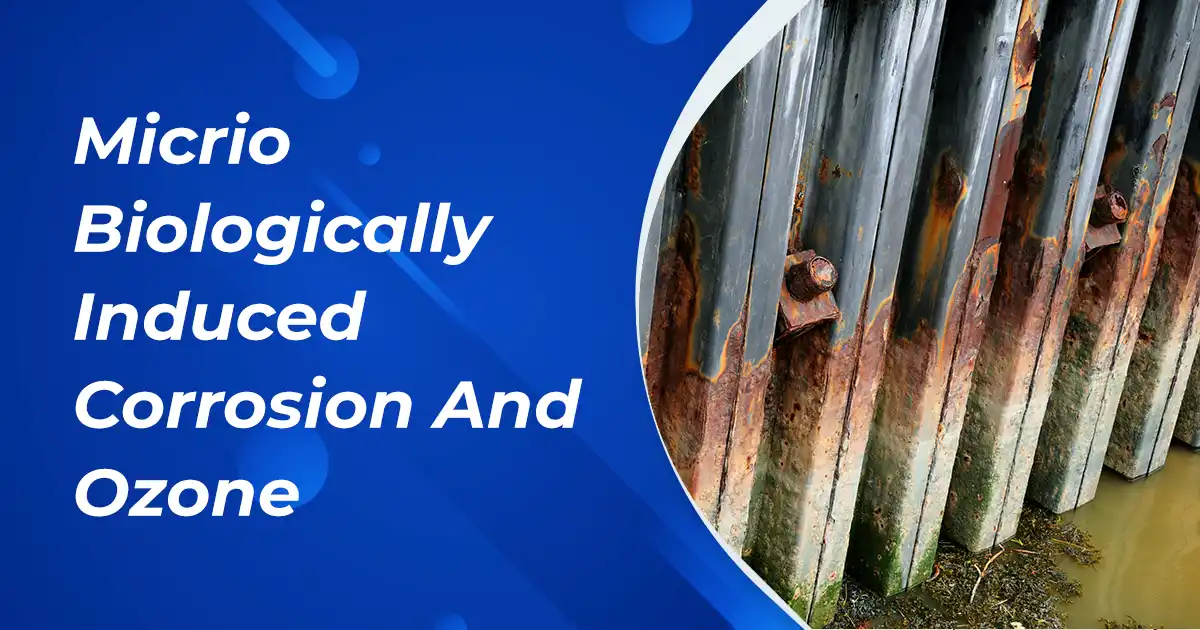Micro Biologically Induced Corrosion And Ozone
Posted on: March 18, 2022
How Ozone Technology Prevents Microbiologically Induced Corrosion

The use of ozone in cooling towers have been the talking point in Industries for many years now. Large power plants in India have begun adopting Ozone Technology. Why has ozone gained so much importance in cooling towers.
ozone controls microbiological growth, and remove or prevent biofilms, If ozone dose is designed well and the residual ozone residual ozone is adequate, ozone reaches the critical surfaces of the cooling towers like condensers, pipes, sumps, etc
Biofilms play a major role in corrosion reactions in cooling systems – both because of their contributions to more direct action by anaerobic bacteria, which generate local acid concentrations that directly attack steel and other ferrous alloys.
Biofilms are formed by the absorption of an initial organic layer, to which bacteria can attach, grow and multiply. The growing bacteria and their by-products form a biofilm layer in which the polysaccharide byproducts anchor the microorganisms to the surface. The biofilm traps nutrients from the cooling water and makes them available to the bacteria, and also protects the bacteria from biocidal actions
Several corrosion mechanisms can exist when biofilms are present. They can establish aerobic colonies that create oxygen depletion site, allow pitting corrosion under anaerobic areas.
Sometimes when oxygen scavenging takes place in upper layers, anaerobe colonies at the metal surface can form corrosive metabolites at these anodic sites, either because iron-oxidizing bacteria stimulate the corrosion, or sulfate reducing bacteria (SRB) develop beneath other growths in the area. Microbiologically induced corrosion is of considerable importance in cooling towers has it effects system performance and service life.
Biofilm areas may utilize oxygen rapidly creating oxygen deficiencies at metal surfaces. These are anodic and so are subject to metal loss. Some anaerobic bacteria like SRB can utilize the hydrogen released at cathodic areas, so causecathodic depolarization, accelerating the anodic corrosion process. Metal coatings often gets removed in patches resulting in in small anodic areas surrounded by large cathodes resulting in rapid metal loss.
When corrosion inhibitors are used, they can be utilized in bacterial metabolism. Polyphosphate inhibitors also can be degraded by bacterial action, so that the polyphosphates are converted to orthophosphates, which react with Ca hardness to form scale deposits. Hence, they lose their effectiveness.
Corrosive metabolites – such as acetic acid or sulfides produced by SRB, which are converted to sulfuric acid by other bacteria. This stimulates Local attack on ferrous metals and alloys.
Role of Ozone
Ozone can minimize these problems by destroying bio films and the “mucilage”, which lets them adhere to metal surfaces. It also can prevent bacterial growth and formation of new bio-films in the system. Other oxidizing biocides also can do this – but ozone is the strongest oxidizer and the most effective biocide
For all this to happen sufficient ozone residual need to me maintained in required areas. Requirement of ozone dose is often controlled by the quality of the makeup water, the environment, and also the turnover time of the cooling tower
1 comment

Shreyas Baratharaj | Director
Sheryas Barathraj has over 15 years of experience in municipal and industrial ozone applications. He has worked on some of the world’s largest ozone installations, with key interests in advanced oxidation, chemical synthesis, pharmaceutical water systems, and municipal drinking water treatment. LinkedIn Bio ›



weed delivery overnight fast service